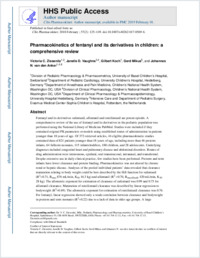Pharmacokinetics of Fentanyl and Its Derivatives in Children: A Comprehensive Review.
- Ziesenitz VC Division of Pediatric Pharmacology and Pharmacometrics, University of Basel Children's Hospital, Spitalstrasse 33, 4056, Basel, Switzerland. Ziesenitz.md@gmail.com.
- Vaughns JD Department of Anesthesia and Pain Medicine, Children's National Health System, Washington, DC, USA.
- Koch G Division of Pediatric Pharmacology and Pharmacometrics, University of Basel Children's Hospital, Spitalstrasse 33, 4056, Basel, Switzerland.
- Mikus G Department of Clinical Pharmacology and Pharmacoepidemiology, University Hospital, Heidelberg, Germany.
- van den Anker JN Division of Pediatric Pharmacology and Pharmacometrics, University of Basel Children's Hospital, Spitalstrasse 33, 4056, Basel, Switzerland.
- 2017-07-09
Published in:
- Clinical pharmacokinetics. - 2018
Adolescent
Alfentanil
Analgesics, Opioid
Body Weight
Child
Child, Preschool
Fentanyl
Humans
Infant
Infant, Newborn
Linear Models
Models, Biological
Remifentanil
Sufentanil
English
Fentanyl and its derivatives sufentanil, alfentanil, and remifentanil are potent opioids. A comprehensive review of the use of fentanyl and its derivatives in the pediatric population was performed using the National Library of Medicine PubMed. Studies were included if they contained original pharmacokinetic parameters or models using established routes of administration in patients younger than 18 years of age. Of 372 retrieved articles, 44 eligible pharmacokinetic studies contained data of 821 patients younger than 18 years of age, including more than 46 preterm infants, 64 full-term neonates, 115 infants/toddlers, 188 children, and 28 adolescents. Underlying diagnoses included congenital heart and pulmonary disease and abdominal disorders. Routes of drug administration were intravenous, epidural, oral-transmucosal, intranasal, and transdermal. Despite extensive use in daily clinical practice, few studies have been performed. Preterm and term infants have lower clearance and protein binding. Pharmacokinetics was not altered by chronic renal or hepatic disease. Analyses of the pooled individual patients' data revealed that clearance maturation relating to body weight could be best described by the Hill function for sufentanil (R 2 = 0.71, B max 876 mL/min, K 50 16.3 kg) and alfentanil (R 2 = 0.70, B max (fixed) 420 mL/min, K 50 28 kg). The allometric exponent for estimation of clearance of sufentanil was 0.99 and 0.75 for alfentanil clearance. Maturation of remifentanil clearance was described by linear regression to bodyweight (R 2 = 0.69). The allometric exponent for estimation of remifentanil clearance was 0.76. For fentanyl, linear regression showed only a weak correlation between clearance and bodyweight in preterm and term neonates (R 2 = 0.22) owing to a lack of data in older age groups. A large heterogeneity regarding study design, clinical setting, drug administration, laboratory assays, and pharmacokinetic estimation was observed between studies introducing bias into the analyses performed in this review. A limitation of this review is that pharmacokinetic data, based on different modes of administration, dosing schemes, and parameter estimation methods, were combined.
- Language
-
- English
- Open access status
- green
- Identifiers
-
- DOI 10.1007/s40262-017-0569-6
- PMID 28688027
- Persistent URL
- https://folia.unifr.ch/global/documents/18606
Statistics
Document views: 5
File downloads:
- fulltext.pdf: 0
